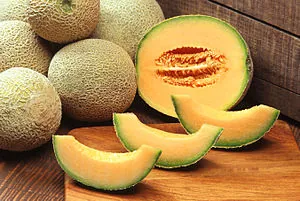Blog
Crazy for Cantaloupe

There is something about this round, orange fleshed, slightly sweet melon that makes everyone love it. The cantaloupe is so well-loved in fact, that it is the most popular melon in the country. And many of the sweetest, highest quality cantaloupes are grown right here in Arizona.
What we call the cantaloupe today is actually a muskmelon and it has been cultivated for over 4000 years. It originates from the Middle East/North Africa region but its modern day name comes from the name of an Italian town where it was first cultivated in the 1700’s. They grow best in warm climates that allow for a long growing season which is one reason they are so well suited to growing here. Here are some more fun facts, interesting tidbits, and delicious uses for cantaloupe.
- Cantaloupe packs a solid nutritional punch and provides a significant dose of vitamins A and C.
- 1 cup of cantaloupe has only 54 calories.
Growing
- Cantaloupe, not surprisingly, belongs to the same family as pumpkins, squashes, gourds, and other melons.
- Many of the melons in the same family as cantaloupes are great at cross-pollinating which means there are many hybrid versions including Jenny Linds, Athena, and Ambrosia.
- The country that produces the most cantaloupes in the world is China. Running a distant second, third, fourth, and fifth are Turkey, Iran, Egypt, and the U.S.
- If you ordered cantaloupe in Europe, your plate would be filled with a ribbed, grey-green skinned melon rather than the tan reticulated skinned melon you would be expecting.
- Dried cantaloupe seeds are a popular snack in many other parts of the world.
- Arizona is second only to California in cantaloupe production here at home.
- There are two growing seasons for cantaloupe in the U.S., one that runs from January to May, and one that runs from July to November.
- Although we have great cantaloupe growing states, we still import a large amount from some of our southern neighbors like Guatemala and Costa Rica.
Buying, Storing, and Enjoying
- To tell if a cantaloupe is ripe, pick it up. Ripe cantaloupes will feel full and heavy. If you tap the rind with your finger it should sound dull, not high or hollow. If the rind feels squishy or spongy, it is overripe.
- You should store your cantaloupe in the fridge for the best result.
- Whole cantaloupe can be stored for 3-4 days. Cut cantaloupe should be eaten within 3 days.
- Cantaloupe needs to be scrubbed clean before slicing because the skin can harbor harmful bacteria like salmonella. Slicing through the skin before washing can contaminate the flesh as well.
- Wait to wash your cantaloupe until you are ready to eat it as water from washing will remain on the rind and increase the likelihood of mold forming.
- Try these great recipes from the Fill Your Plate recipe box using fresh, delicious cantaloupe.
Related articles
- 7 Tips to Eating Your Way to More Energy (fillyourplate.org)
- Margarita Madness (fillyourplate.org)
- Beat the Heat This August (fillyourplate.org)
















